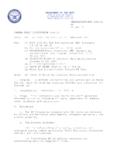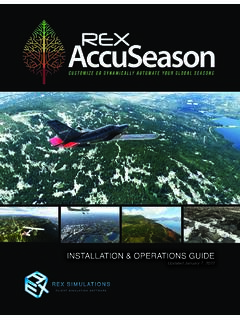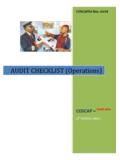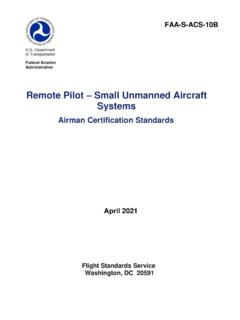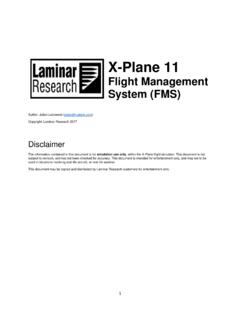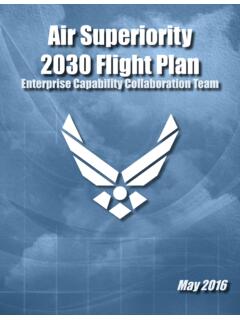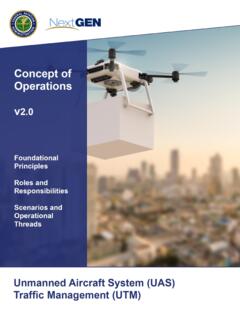Transcription of FLIGHT TRAINING INSTRUCTION - Naval Air Training …
1 Naval AIR TRAINING COMMAND NAS CORPUS CHRISTI, TEXAS CNATRA P-816 (01-14) FLIGHT TRAINING INSTRUCTION CV PROCEDURES (UMFO) T 45C 2014 iii FLIGHT TRAINING INSTRUCTION FOR CV PROCEDURES (UMFO) T-45C P-816 iv LIST OF EFFECTIVE PAGES Dates of issue for original and changed pages are: Jun 97 Jan 14 Change Feb 18 TOTAL NUMBER OF PAGES IN THIS PUBLICATION IS 84 CONSISTING OF THE FOLLOWING: Page No. Change No. Page No. Change No. COVER 0 B-12 (blank) 0 LETTER 0 C-1 C-4 0 iii-v 0 vi - vii 1 viii (blank) 0 1-1 0 1-2 1 1-3 1-16 0 2-1 2-4 0 2-5 1 2-6 2-8 0 2-9 1 2-10 0 2-11 2-12 1 2-13 2-24 0 2-25 2-38 1 A-1 A-6 0 B-1 B-11 0 v INTERIM CHANGE SUMMARY The following Changes have been previously incorporated in this manual: CHANGE NUMBER REMARKS/PURPOSE The following interim Changes have been incorporated in this Change/Revision: INTERIM CHANGE NUMBER REMARKS/PURPOSE ENTERED BY DATE CHANGE 1 vi TABLE OF CONTENTS LIST OF EFFECTIVE PAGES.
2 Iv INTERIM CHANGE SUMMARY ..v TABLE OF CONTENTS .. vi TABLE OF FIGURES .. vii CHAPTER ONE - AIRCRAFT CARRIER operations .. 1-1 100. INTRODUCTION .. 1-1 101. CARRIER ORGANIZATION .. 1-2 102. CARRIER EQUIPMENT .. 1-6 CHAPTER TWO - FLIGHT PROCEDURES .. 2-1 200. INTRODUCTION .. 2-1 201. AIR PLAN .. 2-1 202. FLIGHT DECK 2-3 203. LAUNCH AND DEPARTURE .. 2-4 204. ARRIVAL AND 2-11 205. 2-28 APPENDIX A - GLOSSARY .. A-1 A100. GLOSSARY OF CV PROCEDURES FOR T-45C .. A-1 APPENDIX B - FLIGHT DECK SIGNALS ..B-1 APPENDIX C - LSO RADIO CALLS .. C-1 CHANGE 1 vii TABLE OF FIGURES Figure 1-1 FLIGHT Deck Jersey 1-5 Figure 1-2 Basic Carrier Layout .. 1-6 Figure 1-3 FLIGHT Deck Layout.
3 1-6 Figure 1-4 Improved Fresnel Lens Optical Landing System (IFLOLS) .. 1-12 Figure 1-5 Above, On, and Below Glideslope .. 1-13 Figure 1-6 MOVLAS Components .. 1-14 Figure 1-7 Long Range Laser Lineup 1-16 Figure 2-1 Case I Departure .. 2-10 Figure 2-2 Case II Departure .. 2-10 Figure 2-3 Case I Port Holding Pattern 2-13 Figure 2-4 Case I Overhead Holding Pattern .. 2-14 Figure 2-5 Carrier Landing Pattern .. 2-16 Figure 2-6 Case II/III Marshal Holding .. 2-20 Figure 2-7 Case II Approach 2-21 Figure 2-8 CV 1 Approach .. 2-24 Figure 2-9 Self-Contained GCA .. 2-25 Figure 2-10 Clean Bingo Chart .. 2-30 Figure 2-11 Dirty Bingo Chart.
4 2-33 Figure B-1 FLIGHT Deck Signals 1 ..B-1 Figure B-2 FLIGHT Deck Signals 2 ..B-2 Figure B-3 FLIGHT Deck Signals 3 ..B-3 Figure B-4 FLIGHT Deck Signals 4 ..B-4 Figure B-5 FLIGHT Deck Signals 5 ..B-5 Figure B-6 FLIGHT Deck Signals 6 ..B-6 Figure B-7 FLIGHT Deck Signals 7 ..B-7 Figure B-8 FLIGHT Deck Signals 8 ..B-8 Figure B-9 FLIGHT Deck Signals 9 ..B-9 Figure B-10 FLIGHT Deck Signals 10 ..B-10 Figure B-11 FLIGHT Deck Signals 11 ..B-11 Figure C-1 LSO Radio Calls 1 .. C-1 Figure C-2 LSO Radio Calls 2 .. C-2 Figure C-3 LSO Radio Calls 3 .. C-3 Figure C-4 LSO Radio Calls 4 .. C-4 viii THIS PAGE INTENTIONALLY LEFT BLANK AIRCRAFT CARRIER operations 1-1 CHAPTER ONE AIRCRAFT CARRIER operations 100.
5 INTRODUCTION The aircraft carrier (CVN) plays a critical role in the maritime strategy of the United States. Together with a full complement of support and combat warships, the carrier is the centerpiece of the Carrier Strike Group (CSG). The speed and flexibility of the aircraft carrier and its support group provide our nation with the ability to rapidly respond to world hot spots. As sovereign territory, the aircraft carrier is rapidly deployable and can swiftly bring to bear the entire might of the Carrier Air Wing (CVW), projecting military power hundreds of miles from the Strike Group. This extremely formidable, yet highly flexible Naval force can operate with equal success in confined waters or on the open ocean.
6 This unprecedented force provides the Joint Commander with the operational flexibility and war-fighting capability to meet all Fleet Response Plan (FRP) commitments and presence requirements in support of national strategies. The six core capabilities essential to our maritime strategy are: forward presence, power projection, deterrence, maritime security, humanitarian assistance/disaster response, and sea control. The flexibility and scalability of the CSG provide the means to support any one of these missions. It is capable of selectively controlling the seas, projecting power ashore, and protecting friendly forces and civilian populations from attack. Power projection can be viewed as the threat or actual use of military force against an adversary to either induce or dissuade it from pursuing a given policy or objective.
7 The expeditionary character and versatility of this maritime force provide the the asymmetric advantage of enlarging or contracting its military footprint in areas where access is denied or restricted, while still maintaining the six core capabilities. The speed, precision and lethality of the CSG ensure the Nation s primary forcible entry option and provide the means to respond quickly to other crises. A typical CSG is comprised of an aircraft carrier, at least one cruiser, a destroyer squadron of at least two destroyers and/or frigates, and a carrier air wing of approximately 70 rotary and fixed wing aircraft; additionally, a CSG may also include fast attack submarines, attached logistics ships and a supply ship.
8 The principal role of the carrier and its air wing within the CSG is to provide the primary offensive firepower, while the other ships in the strike group provide defense and support. The aircraft carrier is a sea-going airbase capable of sustaining round-the-clock FLIGHT operations in all weather conditions. As the capital ship in the CSG, the carrier is the centerpiece of power projection. It provides the nation the ability to project air power worldwide without the need for land bases. Referred to as the edge of the envelope, carrier FLIGHT operations involve the most extreme working conditions in a highly dynamic environment. The extremes of operations at sea as opposed to ashore include sustained high operations tempo (Op Tempo), reduced choice for airfield selection and suitable diverts, and statistically a more complex and hazardous environment.
9 Safety and teamwork are essential elements contributing to mishap free and successful carrier operations . A thorough understanding of the procedures and practices is necessary for success when flying and operating in, on, and around the boat. CHAPTER ONE CHANGE 1 AIRCRAFT CARRIER operations 1-2 AIRCRAFT CARRIER operations 101. CARRIER ORGANIZATION The mission of an aircraft carrier (CVN) is to support the aircraft that conduct attack, early warning, surveillance, and electronic missions against the full spectrum of targets in support of joint and coalition forces. In order to accomplish this daunting task, the roughly 5,000 (4,660-5,680) personnel on the carrier must work as a team.
10 Personnel can be broken down into two distinct classifications: Air Wing personnel and ship s company. The success of the carrier and the strike group is directly impacted by the effectiveness of the close working relationship between these groups. 1. Air Wing Personnel The Carrier Air Wing (CVW) is comprised of seven to eight squadrons, numbering approximately 70 rotary and fixed wing aircraft and 2,500 personnel. The typical Air Wing is comprised of: a. 4 VFA (Hornet/Rhino) squadrons b. 1 VAQ (Growler) squadron c. 1 VAW (Hawkeye) squadron d. 1-2 HSC/HSM (Helicopter) squadrons e. 1 VRC (Greyhound) Logistic Support detachment Air Wing Commander. The Air Wing Commander is called CAG.







